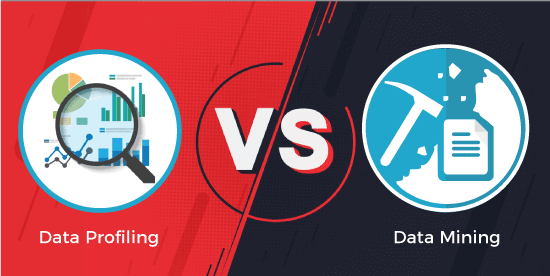Difference between Data Profiling and Data MiningData profiling refers to a process of analyzing the gathered information and collecting insights and statistics about the data. It plays a vital role for any organization since it helps in assessing the quality of data by identifying an issue in the data set. There are multiple methods of conducting data profiling in organizations such as mean, mode, percentile, frequency, maxima, minima, etc. On the other hand, data mining refers to the process of extracting useful data, patterns in the existing database. It is the process of evaluating the existing database and transforming the raw data into useful information. Read on the article to know the difference between data profiling and data mining. What is Data Profiling?Data profiling is also known as data archaeology. It is a process of evaluating data from an existing source and analyzing and summarizing useful information about that data. The primary task of data profiling is to identify issues like incorrect values, anomalies, and missing values in the initial phases of data analysis. It can be done for many reasons, but the most common part of data profiling is to find the quality of data as a component of a huge project. Data profiling is linked with ETL (Extract, Transform, and Load) process to transfer data from one system to another. Data profiling TechniquesThere are three different techniques of data profiling
Structure discovery In structure discovery, the structural identity of the database should be maintained properly. For example, in any organization, consider employees' attendance sheet; the name column can not have numbers, and the phone number columns should have a fixed number of digits. It helps the management team to maintain the accuracy and consistency of the data. Content discovery Content discovery refers to the detailed analysis of structural discovery. It specifically focuses on individual elements for null, ambiguous and redundant data. Relationship discovery Relationship discovery establishes the relationship between various identities. It finds the key relationships and reduces the data overlaps. Methods of data profilingData profiling can be performed in various ways; these are some methods that can be used. Cross Profiling It counts how many times every value appears within each column in a table. It helps to discover the trends and patterns within the data. Cross column The primary purpose of this method is to look across the column to perform key and dependency analysis. Key analysis scans the total values in a table to place a potential primary key. Dependency analysis finds the relationships within the sets of data. Both these analyses find the relationships and dependencies within a table. Cross table profiling Cross table profiling looks across tables to identify the potential foreign keys. It helps find the differences and similarities in syntax and data types between tables to determine which data might be redundant and which could be mapped together. What is Data Mining?Data mining refers to a process used by various organizations to transform raw data into useful information. Many organizations use software to discover data, trends, and patterns in a huge amount of data to understand more about customer behaviours and develop better marketing strategies. Data mining has broad applications in various fields, like the IT sector and science and technology. Data mining is also known as KDD (Knowledge Discovery in Data). These are the given steps involved in the process of data mining Business Understanding: It involves understanding every aspect of the product, and employees do their work accordingly. Data Selection: It involves data selection. Data selection means selecting the best data set from where we can discover and extract data. Data Preparation: In this step, the gathered information is used for the further process. Modelling: In the modelling process, we reconstruct the given data as per the user requirements. Evaluation: Evaluation is one of the most important processes of data mining. It covers every aspect of the process to analyze for a possible fault in the process. Deployment: Once everything is checked, the data is ready to be deployed and used for the next process. Application of data miningData Mining has broad applications such as higher education, science and technology, fraud detection, etc. These are some important applications of data mining.
Difference between Data Profiling and Data Mining
Next TopicPredictive Analytics vs Data Mining
|
 For Videos Join Our Youtube Channel: Join Now
For Videos Join Our Youtube Channel: Join Now
Feedback
- Send your Feedback to [email protected]
Help Others, Please Share









